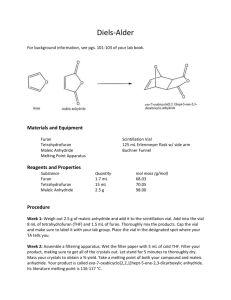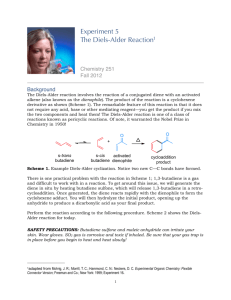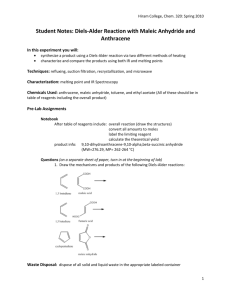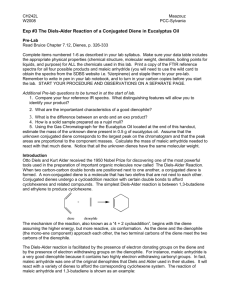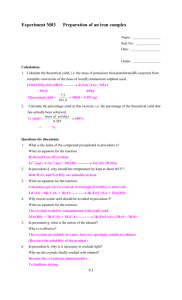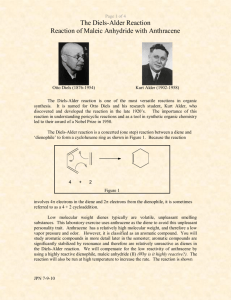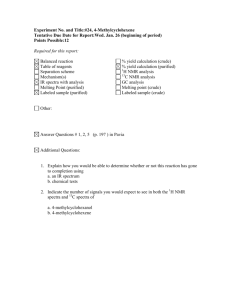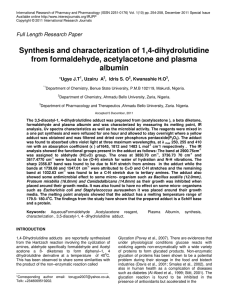1 Name Chemistry 173 Section 20# January 19, 2005 Lab #2
advertisement
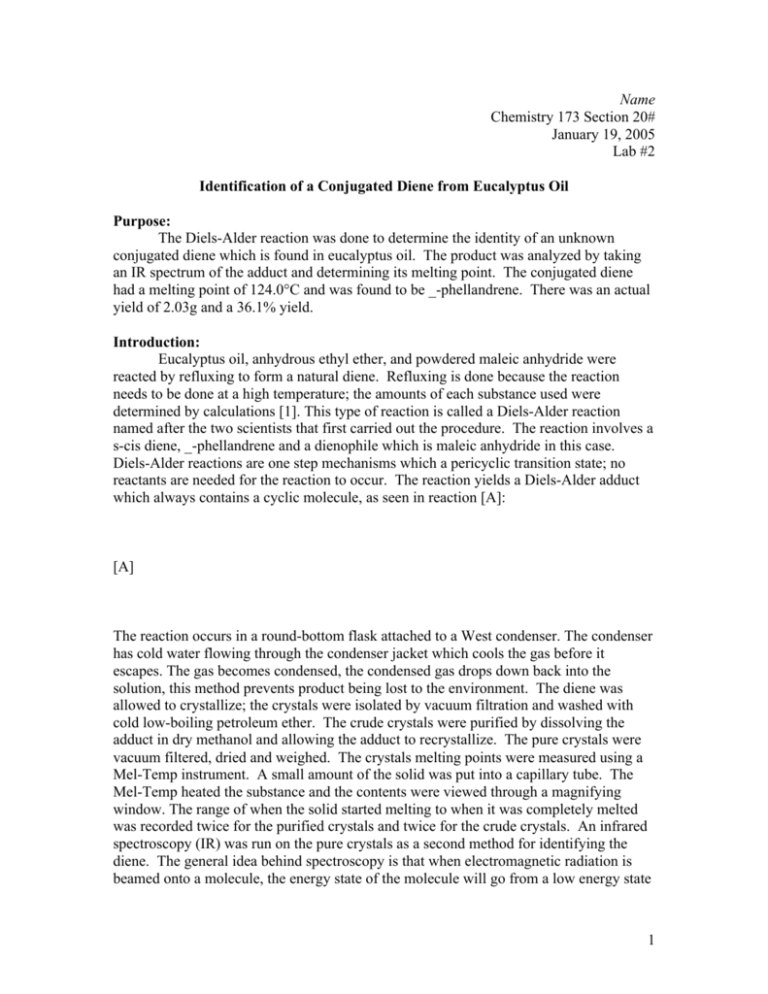
Name Chemistry 173 Section 20# January 19, 2005 Lab #2 Identification of a Conjugated Diene from Eucalyptus Oil Purpose: The Diels-Alder reaction was done to determine the identity of an unknown conjugated diene which is found in eucalyptus oil. The product was analyzed by taking an IR spectrum of the adduct and determining its melting point. The conjugated diene had a melting point of 124.0°C and was found to be _-phellandrene. There was an actual yield of 2.03g and a 36.1% yield. Introduction: Eucalyptus oil, anhydrous ethyl ether, and powdered maleic anhydride were reacted by refluxing to form a natural diene. Refluxing is done because the reaction needs to be done at a high temperature; the amounts of each substance used were determined by calculations [1]. This type of reaction is called a Diels-Alder reaction named after the two scientists that first carried out the procedure. The reaction involves a s-cis diene, _-phellandrene and a dienophile which is maleic anhydride in this case. Diels-Alder reactions are one step mechanisms which a pericyclic transition state; no reactants are needed for the reaction to occur. The reaction yields a Diels-Alder adduct which always contains a cyclic molecule, as seen in reaction [A]: [A] The reaction occurs in a round-bottom flask attached to a West condenser. The condenser has cold water flowing through the condenser jacket which cools the gas before it escapes. The gas becomes condensed, the condensed gas drops down back into the solution, this method prevents product being lost to the environment. The diene was allowed to crystallize; the crystals were isolated by vacuum filtration and washed with cold low-boiling petroleum ether. The crude crystals were purified by dissolving the adduct in dry methanol and allowing the adduct to recrystallize. The pure crystals were vacuum filtered, dried and weighed. The crystals melting points were measured using a Mel-Temp instrument. A small amount of the solid was put into a capillary tube. The Mel-Temp heated the substance and the contents were viewed through a magnifying window. The range of when the solid started melting to when it was completely melted was recorded twice for the purified crystals and twice for the crude crystals. An infrared spectroscopy (IR) was run on the pure crystals as a second method for identifying the diene. The general idea behind spectroscopy is that when electromagnetic radiation is beamed onto a molecule, the energy state of the molecule will go from a low energy state 1 to a higher energy state (Carey, 519). IR spectroscopy uses infrared electromagnetic radiation to elevate a molecules vibrational energy states. This technique is very useful because it identifies functional groups by vibrating the covalent bonds between atoms of the molecule (Carey, 559). Each chemically different bond will vibrate at its own unique wavenumber which is how bonds are recognized in spectroscopy. Material and Methods: The procedure was conducted as stated in the laboratory manual (3) pages 243249. To ensure a proper seal the joints of the round-bottom flask and the West condenser were greased. Two boiling chips were added to the round-bottomed flasks to control the boiling. Each student was able to run their own IR spectrums on their product which the help of the TA’s. Four melting points were taken 2 of the crude and 2 of the pure. 15mL of cold petroleum ether was used to wash the crude crystals. Twenty mL of methanol was used to recrystalize the adduct. Results: The smell of the eucalyptus oil was very strong. When the eucalyptus oil, anhydrous ethyl ether, and maleic anhydride were mixed they turned a neon yellow. Both the pure and crude crystals were white, but the crude crystals looked yellow until they were washed with petroleum ether. The pure crystals were much longer and thicker than the crude crystals. The unknown conjugated diene was determined to be _phellandrene. There was 2.34g of powdered maleic anhydride used [1]. There was an actual yield of 2.03g of pure adduct and a 36.1% yield; for calculations see Table 1. The melting points for the crude and pure crystals are seen in Table 2. The IR spectrum showed prominent bands around 2945, 1800, 1250, and 900cm-1. Discussion: The melting point of the adduct proved that the diene in the eucalyptus oil was _phellandrene. The melting point of the pure adduct was in the range of 123.3-123.9ºC. None of the three other possible dienes had a melting point any where near this high temperature so _-phellandrene must have been the unknown. The IR spectrum also supports the presence of _-phellandrene in the adduct because there are bands around 2945, 1800, 1250, and 900cm-1. The bands that range from 3060-2860 cm-1 suggest the presence of sp2 and sp3 hybridized carbons, both of which are found in _-phellandrene. There are no bands that represent alcohol groups or any bands that represent the presence of nitrogen, which is correct because _-phellandrene is a hydrocarbon. The band around 1800 cm-1 shows the presence of C=O bonds and the bands at 1250 and 900 cm-1 represent the C-CO-O-CO-C unit that is in the maleic anhydride. The reason that the characteristics of the diene and the dienophile are both present in the adduct is because the reaction did not change the structure of the two molecules except for the elimination of two double bonds to create the adduct. Overall the integrity of both molecules are preserved when they get connected. The percent yield of the adduct was low; 36.1%. This low yield is mostly likely due to error that occurred during the experiment. A spatula was used to scrape the flasks and vacuum filter to collect the product which could easily have been a source of error because not all the glassware was scraped completely clean. Also the round-bottomed flask was too small for the condenser and the contents 2 had to be transferred to a larger flask. This transfer led to a loss of some of the reactants and could be the reason why the yield was so low. References: 1) Carey, Francis. Organic Chemistry Fifth Edition. New York, NY: McGraw-Hill Companies Inc., 2003. 2) Iowa State University. Department of Chemistry. 1999-2003. <http://avagadro.chem.iastate.edu/MSDS/MSDS_S.html> (06 Oct. 2004). 3) Lehman, John. Multiscale Operational Organic Chemistry. Upper Saddle River, NJ: Prentice-Hall Inc., 2002. Calculations 1) 3.35g _-phellandrene * (1mol/136.2g)*(1mol/1mol)*(98.1g) = 2.34g maleic anyhdride Table 1 Actual Yield of Pure Diene = 28.19g – 26.16g = 2.03g Theoretical Yield = (maleic anhydride used (g)) (1 mol maleic anhydride/ M.W. maleic anhydride) (molar ratio) (M.W. adduct (g)/1 mol adduct) Theoretical Yield = (2.35g)(1mol/ 98.1g)(1mol/ 1mol)(234.3 g / 1 mol) = 5.62g adduct Percent Yield = (actual yield/ theoretical yield) * 100 % Percent Yield = (2.03g/5.62g) * 100% = 36.1% Table 2 Melting Point Ranges (°C) Crude Diene Impure Diene Trial 1 115.1-117.3 1123.3- 123.8 Trial 2 115.5- 117.1 123.6- 123.9 3

